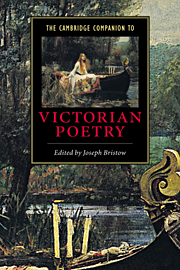Book contents
- Frontmatter
- 1 Reforming Victorian poetry: poetics after 1832
- 2 “The Lady of Shalott” and the critical fortunes of Victorian Poetry
- 3 Experimental form in Victorian poetry
- 4 The dramatic monologue
- 5 Victorian meters
- 6 Victorian poetry and historicism
- 7 Victorian poetry and science
- 8 Victorian poetry and religious diversity
- 9 The Victorian poetess
- 10 The poetry of Victorian masculinities
- 11 Aesthetic and Decadent poetry
- 12 Victorian poetry and patriotism
- 13 Voices of authority, voices of subversion: poetry in the late nineteenth century
- Glossary
- Guide to Further Reading
- Index
4 - The dramatic monologue
Published online by Cambridge University Press: 28 May 2006
- Frontmatter
- 1 Reforming Victorian poetry: poetics after 1832
- 2 “The Lady of Shalott” and the critical fortunes of Victorian Poetry
- 3 Experimental form in Victorian poetry
- 4 The dramatic monologue
- 5 Victorian meters
- 6 Victorian poetry and historicism
- 7 Victorian poetry and science
- 8 Victorian poetry and religious diversity
- 9 The Victorian poetess
- 10 The poetry of Victorian masculinities
- 11 Aesthetic and Decadent poetry
- 12 Victorian poetry and patriotism
- 13 Voices of authority, voices of subversion: poetry in the late nineteenth century
- Glossary
- Guide to Further Reading
- Index
Summary
Early in Augusta Webster's dramatic monologue, “An Inventor” (1870), the speaker expresses his frustration over a contraption that he has not yet perfected. “It must,” he insists, “perform my thought, it must awake / this soulless whirring thing of springs and wheels, / and be a power among us” (119). These desperate imperatives (“it must”) are followed by a question that might betray a sense of futility were it not also the question of any innovator: “Aye but how?” The speaker seeks public exhibition or display of his thought; only then can the object be “a power among us,” and so enjoy a social and cultural import beyond even its maker. But the phrase also suggests a more pragmatic, less theatrical, and less hierarchical imperative for the object: it must execute his thought, it must accomplish or fulfill some action or deed, and it must be effectual.
The notion of creating a vehicle for the performance of thoughts may remind us of another nineteenth-century invention: the dramatic monologue itself. This chapter explores the element of performance in the dramatic monologue, the ways these poems enact or express aspects of their speakers, and the ways in which these varied monologues are "dramatic." It will also, however, pursue what we might term the performative element of the dramatic monologue, the methods by which these discursive forays, these words, accomplish various goals - some apparent, others subtle and less readily perceptible.
- Type
- Chapter
- Information
- The Cambridge Companion to Victorian Poetry , pp. 67 - 88Publisher: Cambridge University PressPrint publication year: 2000
- 6
- Cited by



